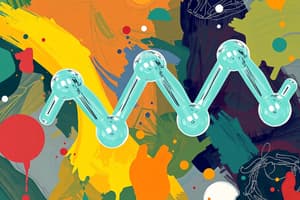Podcast
Questions and Answers
What is the general rule regarding the proportion of hydrogen and oxygen atoms in a carbohydrate molecule?
What is the general rule regarding the proportion of hydrogen and oxygen atoms in a carbohydrate molecule?
- There are twice as many hydrogen atoms as oxygen atoms (correct)
- There are three times as many hydrogen atoms as oxygen atoms
- There are equal numbers of hydrogen and oxygen atoms
- There are four times as many hydrogen atoms as oxygen atoms
What is the basic unit structure of a carbohydrate?
What is the basic unit structure of a carbohydrate?
- Monomer
- Polysaccharide
- Saccharide (correct)
- Oligosaccharide
How many saccharides does a polysaccharide contain?
How many saccharides does a polysaccharide contain?
- 1
- More than 10 (correct)
- 3-10
- 2
What does the prefix 'mono' mean in the context of monosaccharides?
What does the prefix 'mono' mean in the context of monosaccharides?
What is the meaning of the word 'carbohydrate' derived from?
What is the meaning of the word 'carbohydrate' derived from?
How is a disaccharide classified based on the number of saccharides it contains?
How is a disaccharide classified based on the number of saccharides it contains?
What are macromolecules?
What are macromolecules?
Which statement about monosaccharides is correct?
Which statement about monosaccharides is correct?
What is the defining characteristic of disaccharides?
What is the defining characteristic of disaccharides?
What distinguishes oligosaccharides from other carbohydrate types?
What distinguishes oligosaccharides from other carbohydrate types?
Which statement accurately describes polysaccharides?
Which statement accurately describes polysaccharides?
What sets nonstarch polysaccharides apart from other carbohydrates?
What sets nonstarch polysaccharides apart from other carbohydrates?
What is a characteristic of the solubility of carbohydrates in water?
What is a characteristic of the solubility of carbohydrates in water?
What can carbohydrates be oxidized to?
What can carbohydrates be oxidized to?
What is a common characteristic of carbohydrates?
What is a common characteristic of carbohydrates?
What is the chemical formula for glucose, fructose, and galactose?
What is the chemical formula for glucose, fructose, and galactose?
Which disaccharide is made of glucose and fructose?
Which disaccharide is made of glucose and fructose?
What is the chemical formula for sucrose, maltose, and lactose?
What is the chemical formula for sucrose, maltose, and lactose?
Which molecule is a polysaccharide glucose storage molecule for many animals?
Which molecule is a polysaccharide glucose storage molecule for many animals?
What is the chemical formula for amylose and glycogen?
What is the chemical formula for amylose and glycogen?
Which type of carbohydrate is cellulose?
Which type of carbohydrate is cellulose?
What is the chemical formula for cellulose?
What is the chemical formula for cellulose?
What property of carbohydrates allows them to be extremely soluble in water?
What property of carbohydrates allows them to be extremely soluble in water?
Flashcards are hidden until you start studying
Study Notes
Carbohydrates: Structures and Functions
- Monosaccharides include glucose, fructose, and galactose, sharing the same chemical formula but differing in structure and atom arrangement.
- Glucose, fructose, and galactose are isomers, with glucose existing in both linear and ring forms and differing from galactose in hydroxyl group orientation.
- Disaccharides, such as sucrose, maltose, and lactose, are formed by joining two monosaccharides in their ring form, with the same chemical formula as their constituents.
- Oligosaccharides contain three to 10 saccharides linked together, examples being oligofructose, raffinose, and maltotriose, each with their own chemical formula.
- Polysaccharides, like amylose and glycogen, consist of more than 10 saccharides linked together, with the same chemical formula as monosaccharides and nonstarch polysaccharides.
- Nonstarch polysaccharides, such as cellulose and inulin, are complex carbohydrates and dietary fibers with different glycosidic linkages and chemical formulas.
- Carbohydrates consist solely of carbon, hydrogen, and oxygen atoms, can exist as open chains or ring structures, and have the ability to share the same chemical formula but differ in structure and configuration.
- They can be oxidized to carboxylic acids and reduced to alcohol, have a sweet taste, are solid at room temperature, and are highly soluble in water due to their hydrophilic nature.
- The solubility of carbohydrates in water makes them a useful energy source, as they can exist in hydrophilic environments like the bloodstream and inside cells.
Studying That Suits You
Use AI to generate personalized quizzes and flashcards to suit your learning preferences.





